Gas processing news
H. Meche, Associate Editor
Four engines ordered for two LNG carriers
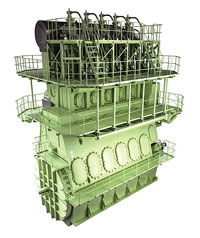
MAN Diesel & Turbo SE announced an order for four MAN B&W 5G70 ME-GI engines in connection with an agreement between Daewoo Shipbuilding and Marine Engineering Co. Ltd. (DSME) and the BW Group to build two LNG carriers. The 173,400-m3 vessels are scheduled for delivery in late 2017/early 2018 and will be built at DSME’s Okpo shipyard in Geoje, Korea. The deal represents the second LNG ME-GI contract for DSME after a previous order that was signed in 2012.
The ME-GI engine offers the option of using fuel or gas, depending on relative price and availability, as well as on environmental considerations. Its high-pressure gas-injection function allows it to maintain the positive attributes of MAN B&W low-speed engines.
The technical engine specification complies with International Maritime Organization (IMO) Tier 2 regulations, with options to include remedies for Tier 3 compliance at a later stage. Compliance with IMO Tier 3 rules requires an approximately 80% reduction in NOx emissions—compared to Tier I regulations—within the designated emission control areas (ECAs) over a defined test cycle. MAN Diesel & Turbo’s selective catalytic reduction (SCR) and exhaust gas recirculation (EGR) methods enable compliance with stringent regulations.
Research indicates that the ME-GI engine delivers significant reductions in CO2, NOx and SOx emissions. An ME-LGI counterpart that uses LPG, methanol and other liquid gases is also available, and has already been ordered.
Bestobell Marine secures valve contract
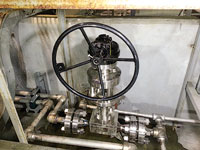
The valve manufacturer has received its first order to supply a new range of cryogenic high-pressure (HP) globe valves to Daewoo Shipbuilding and Marine Engineering (DSME) in South Korea.
The valves, developed over the past two years in conjunction with DSME, meet the standards required for valves in the new fuel gas systems, which include withstanding a maximum pressure of 370 bar.
The valves will be fitted in the fuel gas system’s gas phase piping. LNG is injected into the engine at approximately 300 bar, with the valve and piping system designed to withstand HP. The valves are due for delivery at the end of 2014.
Bestobell Marine is reportedly the only manufacturer of HP cryogenic globe valves for use in gas-fueled marine engines with the necessary class approvals, certification and 3.2 traceability on all components.
The valves will be installed on five 174K LNG carriers being built by DSME on behalf of Teekay LNG Partners LP of Canada.
Utilities review peers to elevate safety
The American Gas Association (AGA) board of directors has approved the first-ever national AGA Peer Review Program, a peer-to-peer safety and operational practices review program. The program will allow local gas utilities to observe their peers, share leading practices and identify opportunities to better serve customers and communities.
Beginning in 2015, companies from the more than 200 local utilities that make up AGA’s membership will volunteer to team up in peer groups of three to four companies to visit one another’s facilities and conduct detailed reviews focusing on key aspects of pipeline and employee safety.
The approval of the review program follows the successful completion of a pilot program conducted from June 2013 through March 2014, involving 10 AGA member companies.
While other industry sectors have implemented peer safety reviews, this is the first program of its kind in the gas utility industry to be taken to a national level. The national program will examine aspects of safe gas operations, including safety culture, pipeline safety risk management and technical training and worker procedures.
Once companies have completed reviews of these topics, they will have the opportunity to participate in reviews of other areas, including construction and contractor oversight and emergency preparedness and response, as well as public awareness, damage prevention, quality control and workforce development.
Dewpoint calibration project makes progress
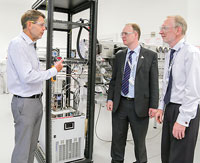
Michell Instruments Research has reported progress in its project with the UK National Physical Laboratory (NPL) to improve high-pressure dewpoint generator technology.
Michell scientists are cooperating on the project
with the NPL, which provides scientific consultancy and assessment services. The aim
is to enable calibrations of water and hydrocarbon dewpoints to be made at line pressure, outside of national metrology institutes.
The research has implications for the natural gas industry, especially for pipeline operators, as performing at-pressure calibrations for water and hydrocarbon dewpoints will improve confidence in the measurements of these two gas-quality parameters at pipeline custody-transfer points.
The system offers operating flexibility at pressures up to 1,450 psi with a choice of carrier gases, such as methane, to simulate process application conditions.
Industry project to combat pipeline corrosion
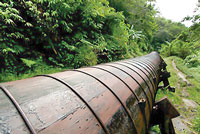
Microbiologically influenced corrosion (MIC) is one of the leading causes of corrosion failures in onshore transmission pipelines. DNV GL is calling for partners to collaborate in a joint industry project (JIP) to develop a recommended practice (RP) for detecting and mitigating MIC.
Microorganisms adhering to metal surfaces and forming biofilms (complex microbial ecosystems) can alter electrochemical conditions on the metal surface, inducing corrosion, which most commonly occurs as pitting. As it is nearly impossible to prove the presence of MIC directly without excavating the suspected site, MIC can be found by detecting coating degradation using direct current voltage gradient. The pipeline’s metal loss can be found using inline inspection.
The JIP will focus on preventing MIC by exploring the role of coating condition and cathodic protection in the prevention of MIC. It will identify ways to support pipeline operators in detecting possible MIC sites by testing and selecting the best measurement techniques. The project will also develop a decision-support tool to rank the risk of MIC-sensitive areas along a pipeline.
The final outcome of the JIP will be an industry-wide RP, establishing industry guidelines and recommendations to predict, detect and mitigate the occurrence of MIC.
Partnership offers pipeline leak detection
Through a cooperation agreement, GE’s Measurement and Control business and Atmos International now offer a more comprehensive leak-detection solution to pipeline customers.
The partnership combines GE’s flowmetering product line and expertise with Atmos’ pipeline technology. The integration of these offerings optimizes pipeline monitoring for detecting leaks and product thefts.
Truck company adds gas option
Kenworth Truck Co.’s Kenworth T880 day cab and 52-in. mid-roof sleeper configurations can now be specified with the factory-installed Cummins Westport ISX12 G 400-hp natural gas engine with 1,450 lb/ft of torque.
The ISX12 G engine is available with manual, automatic and Eaton UltraShift Plus transmission options, including 10-speed linehaul active shifting (LAS) and the 13-speed multipurpose high-performance (MHP) series.
The Cummins Westport ISX12 G engine can run on either CNG or LNG fuel systems. The engine uses a maintenance-free, three-way catalyst and does not require a diesel exhaust fluid tank, a diesel particulate filter or selective catalytic reduction technology.
Kenworth works with companies including Agility Fuel Systems, Trilogy Engineered Solutions and McNeilus to provide natural gas tanks and fueling systems.
Midstream firm selects integrated measurement
Flow-Cal Inc. has implemented its FLOWCAL enterprise liquids application at a new midstream business, EnLink Midstream, and it is installing the FLOWCAL Enterprise Gas application.
EnLink was created by merging the assets of Devon Energy with Dallas, Texas-based Crosstex Energy, to form one of the largest midstream companies in the US. Prior to creating EnLink, Crosstex Energy had already selected Flow-Cal’s system to replace a competing measurement product. The FLOWCAL Liquids system enables EnLink to manage all measurement data from its fractionating and processing facilities, pipelines, and truck
and railcar transportation tickets.
With the Enterprise Liquids application already in use, EnLink will add gas functionality as an integrated solution, enabling the company to manage all gas and liquids measurement data from a single source.
Flow-Cal’s suite of products gather, validate, store and distribute a company’s volume and energy data. The data validation and editing features automate field data processing, producing accurate and auditable results that meet or exceed industry standards.
Flowmeter helps meet flare reporting rules
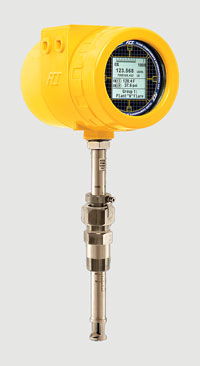
The ST100 Series thermal mass air/gas flowmeter from Fluid Components International (FCI) provides a US Environmental Protection Agency (EPA)-compliant solution to measure flare gas
flows at the wellhead.
US EPA Directive 40 CFR, Part 98 requires flow measurement and reporting of flared gases. This can be difficult, since these gases have very low flowrates [15 feet per second (fps) to 20 fps], contain mixed gas compositions, can potentially include dirty gas, and have elevated temperatures and a wide pressure variation.
Wellhead sites are often remotely located, with limited access to recording and data acquisition systems. The equipment can be exposed to severe weather conditions, and installations are in hazardous areas requiring instruments with full Ex approvals rated for Class 1, Division 1 (Zone 1) locations.
The ST100 flowmeter is suitable for these shale gas fracing well drilling operations. It includes a digital readout with totalizer, analog or digital bus communications outputs and an onboard data logger.
FCI’s thermal flowmeters can measure flowrates as low as 0.25 fps and as high as 1,000 fps with up to 1,000:1 turndown. They are calibration-matched to specific mixed gas compositions and to the installation’s temperature and pressure conditions. The flowmeters also store up to five unique calibrations, and their accuracy meets EPA regulations.
Agreement to strengthen LNG cooperation
Eni and Korea Gas Corp. (KOGAS) hope to further strengthen their relationship, through a cooperation agreement, in the upstream and LNG sectors, and to jointly pursue opportunities worldwide.
The companies expect that the agreement will enable LNG development of Area 4 in Mozambique, where operator Eni holds a 50% indirect interest. The partners—KOGAS, Galp Energia and ENH—each hold a 10% interest, and CNPC has a 20% indirect participation.
Area 4’s total resources are estimated to be approximately 85 Tcf of gas in place, and it is ready to enter the development phase in 2015.
The cooperation agreement confirms the success of Eni and KOGAS’ partnership, which has been involved in five upstream projects in Mozambique, Cyprus, Iraq, Indonesia and Timor Leste.
Small-scale GTL plant to be built in Houston
Greyrock Energy announced a final investment decision to deliver a small-scale GTL facility near Houston, Texas. The plant will be commercially operational by the end of 2015.
Greyrock is targeting midstream operators and producers that can profit by transforming low-cost natural gas into higher-value transportation fuels without the costly, large-scale processes that are typical of traditional GTL solutions. The project is being funded by a consortium of investors led by Sterling Private Capital and Eagle Oil & Gas Co.
Greyrock’s facilities produce premium synthetic diesel fuel from natural gas or NGL using the company’s GreyCat catalyst and Distributed GTL (dGTL) solution.
Modular gas conversion can be achieved from a variety of abundant gas sources, including natural gas, NGL such as ethane, stranded gas resources and associated gas.
According to Eagle Oil & Gas Co., the project will allow for the conversion of NGL in geographies where ethane pricing is depressed and a challenge to producers.
BV to class first LNG bunker barge
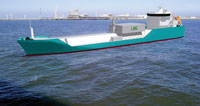
The international classification society Bureau Veritas (BV) will classify the unique LNG bunkering vessel, which will be built at Hanjin Heavy Industries in South Korea, under an agreement between Japan’s NYK and Mitsubishi and France’s GDF SUEZ.
The vessel will carry 5,000 m3 of LNG for ship fuel, stored at 4 bar in two International Maritime Organization (IMO) Type C pressure tanks. Delivery is set for 2016, when the vessel will operate from the Fluxys LNG terminal in Zeebrugge, Belgium, initially supplying LNG fuel from GDF SUEZ to the fleet of United European Car Carriers.
The LNG bunker barge will have an overall length of 111 m, a 16.8-m beam and a 4.9-m draft, as well as dual-fuel diesel electric propulsion with twin azipods for high maneuverability.
CB&I gets gasification contract in China
CB&I will license its proprietary E-GasPlus technology to, and provide engineering design for, Shandong Sincier Petrochemical Co. Ltd.’s three-train gasification facility, which is to be built near Dongying, Shandong province, China.
The plant will produce syngas for hydrogen, fuel gas and power. It will be able to operate on coal and petroleum coke, or a combination of these fuels, with a liquid or solid residue from an upstream hydrocracking unit.
Sincier has licensed six other process units using CB&I’s technology to make octane-boosting gasoline blendstocks, to upgrade residues and to produce petrochemicals. GP




Comments